Consultants Propose Changes to Building Code to Reduce Bulk and Lot Coverage
- Thursday, 16 May 2024 11:41
- Last Updated: Friday, 17 May 2024 07:32
- Published: Thursday, 16 May 2024 11:41
- Joanne Wallenstein
- Hits: 3696
 What will be the outcome of a six-month building moratorium in Scarsdale? Will oversized homes on undersized lots be a thing of the past? How close is too close to the property line or the street for a home to be built? How much of a lot can be covered with impervious surfaces? Will treasured historic homes continue to be knocked down and replaced with two cookie cutter homes jammed onto a lot in the place of one?
What will be the outcome of a six-month building moratorium in Scarsdale? Will oversized homes on undersized lots be a thing of the past? How close is too close to the property line or the street for a home to be built? How much of a lot can be covered with impervious surfaces? Will treasured historic homes continue to be knocked down and replaced with two cookie cutter homes jammed onto a lot in the place of one?
These were just some of the issues that elicited a petition from concerned residents in October 2023 and led to the establishment of a building moratorium in January 2024. During the moratorium the Village took a pause on the approval of new building applications and retained BFJ Planning to study and make recommendations on the following:
-Reduce the appearance of bulk
-Reduce stormwater runoff
-Architectural guidelines for principal dwellings
-Maximum buildout analysis
-Historic preservation of older homes
The charge was to examine these issues and “develop specific zoning code changes that effectively address the community’s concerns.”
Working with the consultants were Acting Village Manager Alexandra Marshall, Village Planner Kellan Cantrell, Village Engineer David Goessl, Building Inspector Frank Diodati, Superintendent of Public Works Jeff Coleman, and Village Attorney Nicholas Ward Willis. The Mayor and Trustees Brew and Gans also attended some meetings.
Now five months later, at a work session on Tuesday May 14, 2024, the consultants provided their recommendations to address three items on the list and suggested that two additional items, architectural guidelines and historic preservation, could be examined in a separate contract at a later date.
In order to address lot coverage and home bulk BFJ proposed a long series of changes to existing code. Though many of the proposed changes look like modest tweaks to current regulations, the cover memo from the consultants explains, “Each recommendation alone would not be drastic: however, when combined, they address the two main issues described in the moratorium: the appearance of bulk and stormwater impact.”
Listening to the presentation, it was difficult to envision the potential effects of these changes. Would they prevent some of the most egregious examples of overbuilding that led to the moratorium?
For example, for a house on 1/3 of an acre (15,000 square feet), would increasing the side yard setback by a foot on either 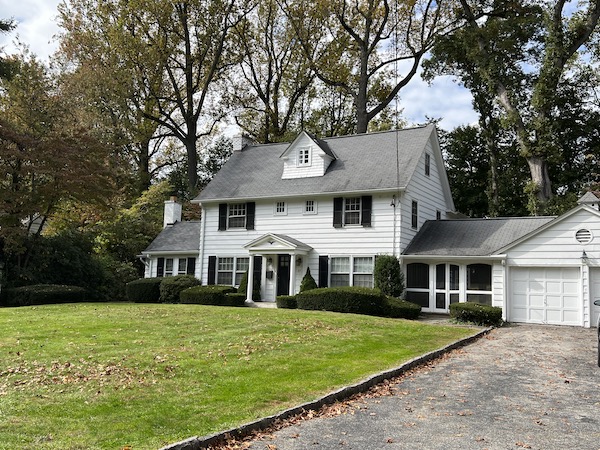 Neighbors fought an application to demolish 27 Woods Lane, which the buyers proposed to take down and build two homes in its place. Would the new laws prevent that?side, and taking 90 square feet off a 4,800 square foot house noticeably reduce the appearance of bulk? Without renderings, simulations and visual examples of how these new regulations would impact the design and siting of new homes it was hard to know. Perhaps the consultants can provide these visuals so that residents and builders can envision the potential impacts of the revisions.
Neighbors fought an application to demolish 27 Woods Lane, which the buyers proposed to take down and build two homes in its place. Would the new laws prevent that?side, and taking 90 square feet off a 4,800 square foot house noticeably reduce the appearance of bulk? Without renderings, simulations and visual examples of how these new regulations would impact the design and siting of new homes it was hard to know. Perhaps the consultants can provide these visuals so that residents and builders can envision the potential impacts of the revisions.
The report also suggested far reaching changes in the application process, shifting some decisions from the Board of Architectural Review to the Planning Board, and requiring variances for work on non-conforming lots which would be provided by the Zoning Board of Appeals. From the presentation, it was difficult to understand the new approval process; which board would see the application first and how an application would proceed. More work is needed to clarify these points, as in the past, applicants have exploited gaps in procedure to get around Village Code.
Here are highlights of the proposal. Review the entire document here:
Role of the Planning Board
The code change would increase the role of the Planning Board. All applications for building within flood hazard areas would need to get the approval of the Planning Board.
Planning Board review would also be required for any development that impacts the adjoining property buffer. How much disturbance would trigger the need for Planning Board approval? A graduated chart of the thresholds of the percentage of the site that is disturbed for each zoning district is included. Would the Planning Board have the authority to deny an application based on issues with site disturbance?
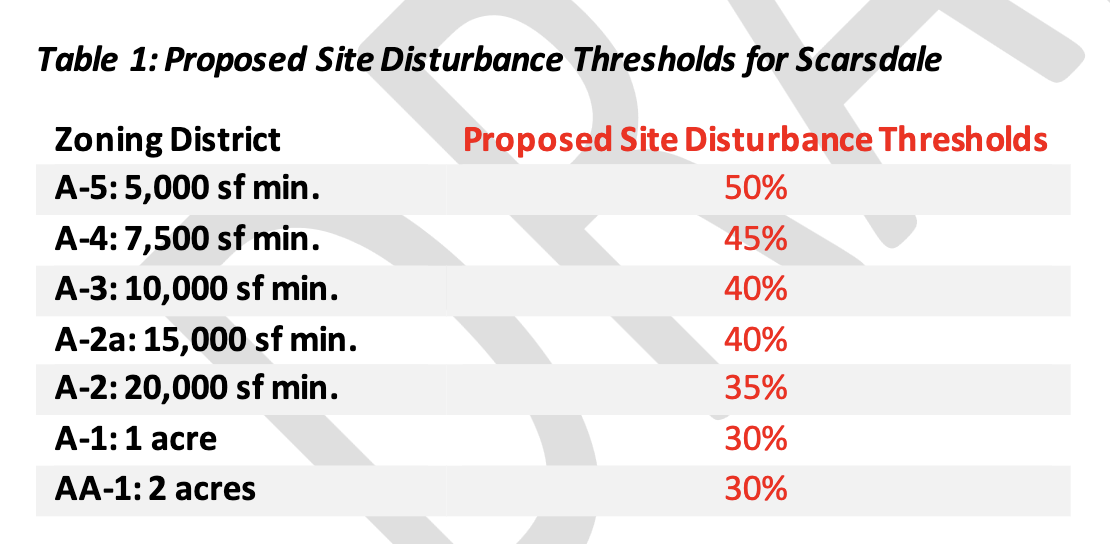
As the Village currently has no regulations for potential flooding during construction, developers building in flood zones would need to provide and get approval for a Construction Management Plan to show how they are going to protect neighbors from excess water and soil runoff during the building process.
Homes on corner lots, which often appear to be too bulky would also need to be reviewed by the Planning Board due to “their unique sight lines and high visibility.”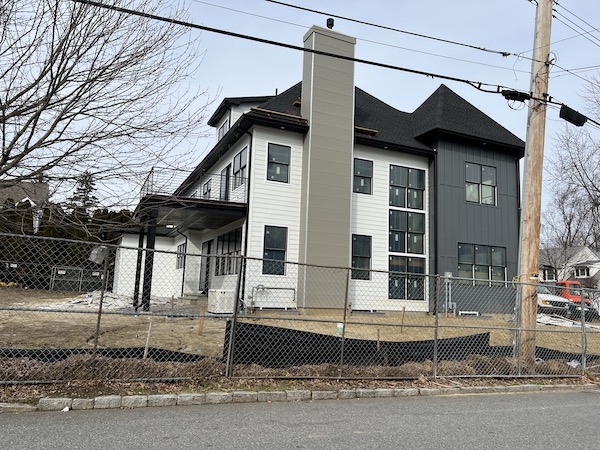 A new home on a corner lot on Carthage Road
A new home on a corner lot on Carthage Road
Open Space Requirement
Another new requirement would be to set requirements for the amount of open space on each lot size. The proposal defines open space as “unoccupied by any structure, building, parking, paving, or other surfaces deemed to be impervious, and which is vegetated and open to the sky, either it is natural unimproved state or landscaped with lawn, trees and other plants, natural rock outcropping, natural water features or wetlands.” The effect should be to limit the coverage of the home, patio, driveway and accessory buildings and preserve green space.
Side Yard setbacks
The consultants propose modest increase in side yard setbacks for most lot sizes. For instance, for 1/4 acre lots, the side yard setback is now 10 feet. The new requirement would be 12 feet. Setbacks for accessory buildings like garages would also be required.
Floor Area Ratio
The proposal includes a small change to the Floor Area Ratio calculation by rounding off the decimal in the formula to the nearest 100th.. place. The change in total FAR permitted is negligible.
Builder’s Bonus
Current building code grants bonus square footage of 100 square feet of floor space for each foot that a house is set back beyond the minimum side yard set back in all zones except those in AA-1 – which are lots of 2 acres and above. Currently, there is a maximum bonus of 280 feet for zones A4 (.17 acres) and A5 (.11 acres), and a maximum of 490 square feet for lots in A2 (half acre) A-2a (1/3 acre) and A3 (1/4 acre) and 840 square feet for homes in A1 on one acre lots.
The consultants recommend small reductions in the bonus as show in the chart below. No one discussed the possibility of eliminating the bonuses all together.
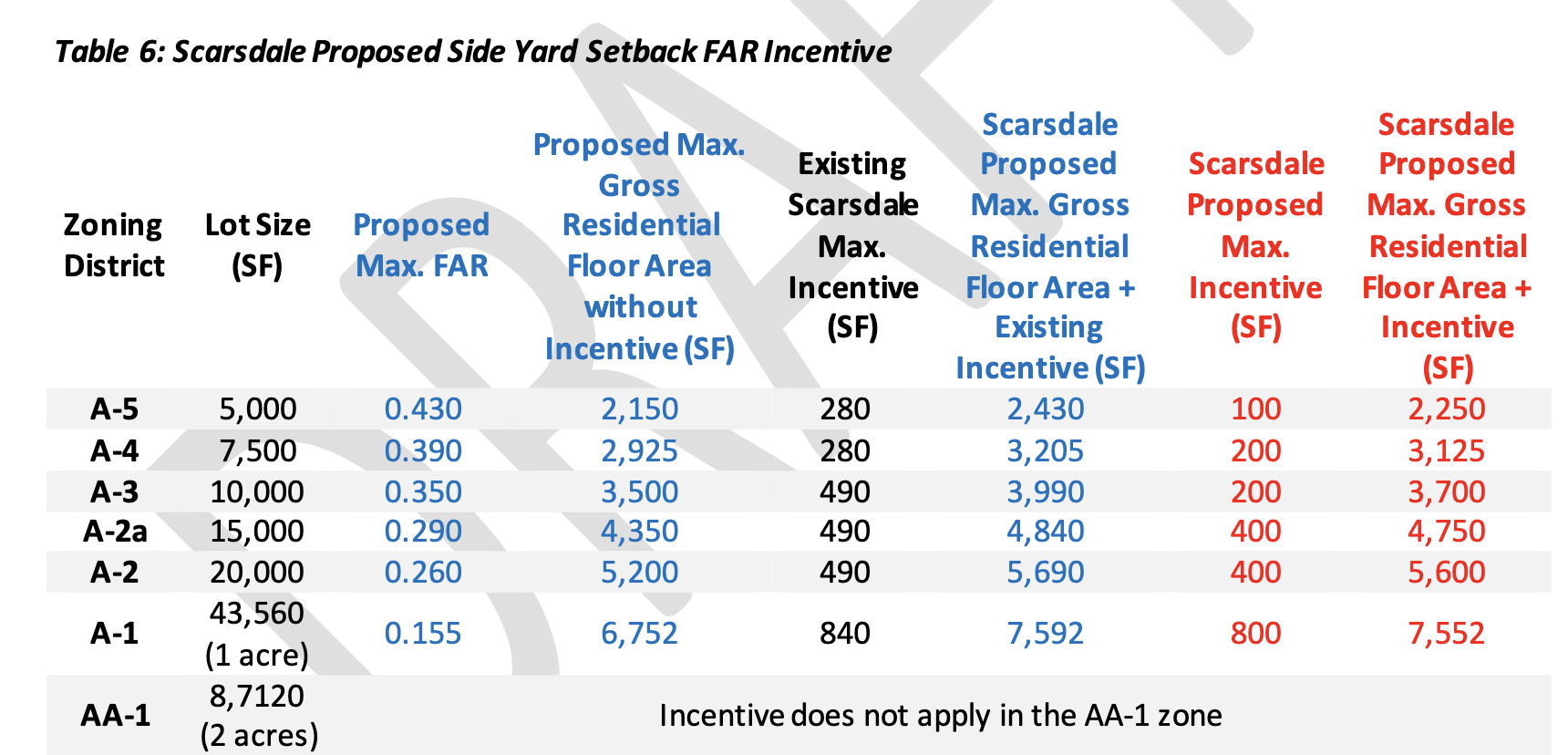
Impervious Surfaces
In order to safeguard open space to reduce flooding, building code defines how much of a lot can be impervious, meaning covered by a building, a driveway, a patio etc. Currently gravel and porous asphalt is considered “pervious” and thus allows more lot coverage. The consultants recommend changing these definitions so that gravel and porous asphalt are considered impervious and counted in the lot coverage formula. They also propose allowing the use of “permeable pavers,” instead of gravel or asphalt.
Lot Coverage
The proposal includes reductions in the permissible lot coverage on lots 1/3 acre and greater. See the chart here:
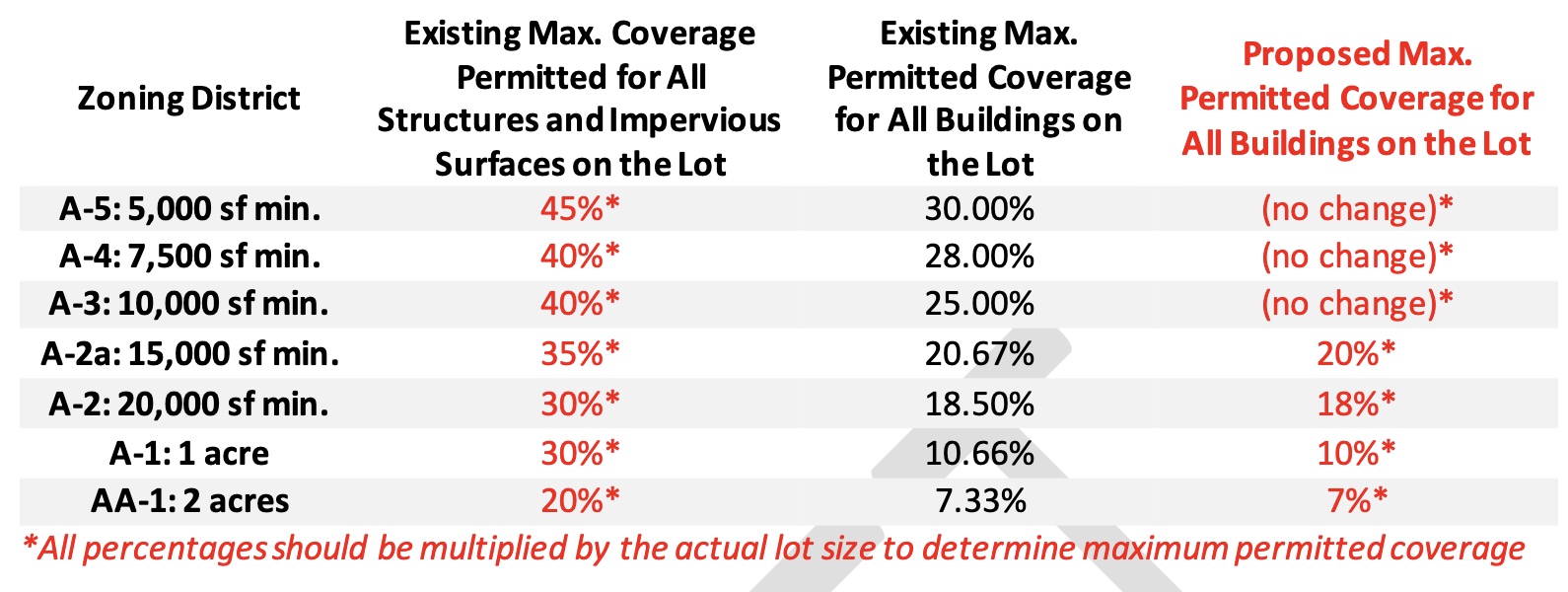
Height of Homes on Lots 2 Acres or Greater
The proposal includes a “sky incentive” to permit those building on 2 acres or more to increase their setbacks and be permitted to increase the height of the roof from 32 feet to 36 feet in order to create pitched roofs in proportion to the home.
Height of Homes in Flood Hazard Areas
The consultants suggest permitting homes built in flood hazard areas to be permitted 3 feet more in roof height (35 feet). This was suggested so that the entire home could be raised out of the flood plain. However, currently Scarsdale discourages any building in flooded areas so it was not clear why this proposal was drafted.
Escrow
Under the proposed code change, the Village could require applicants to escrow funds to reimburse the Village for fees for the professional review of applications or a SEQRA review. The Village would not issue a certificate of occupancy unless all professional review fees charges had been paid.
What’s Next?
Once the trustees approve the proposed changes the proposed code would be referred to the Westchester County Planning Board and the Scarsdale Planning Board for review, a report and a recommendation. A SEQRA review of the draft law would also be required.
In the discussion that followed the presentation, trustees noted the increased role of the Planning Board and questioned whether more training would be needed, if the size of the Planning Board would need to be increased, if they would need to meet more frequently and if more members would need to be added to the board.
Also discussed was the fact that the consultants had delineated building requirements by zoning district rather than lot size. Since there are variations in lot sizes in districts, in some cases this would permit more rather than less coverage and home size.
Discussing non-conforming lots which would result from the new code, the question was posed, “If the setbacks changed, would you be permitted to build a second story over the first with the original setback?” The answer was that the resident would need a variance from the Zoning Board of Appeals.
The Mayor noted that the code proposal did not address historic preservation, as there was not enough time during the six month moratorium to address the preservation laws as well as the building code. Since many of the building issues are a result of home demolitions, problems may still occur.
The code changes also did not address subdivisions and tree removals or the recommendations of the Scarsdale Forum which some hoped would be included in the proposal. Front yard setbacks were not addressed either. Often an older home, which is set back from the street at a gracious distance is replaced with one that looms over the sidewalk. These were many of the issues that brought dismayed residents to Village Hall in the first place.
The Village Board plans to hold two work sessions on the proposed code changes on May 28 and June 11, 2024. The current moratorium expires on July 19, 2024. If the changes are approved by the Westchester County Planning Board and the Scarsdale Planning Board and get SEQRA approval the new code would go into effect in January 2025. Until that time, the current code remains in place.
It will be interesting to see if all of the questions can be resolved in just eight weeks.
John Clapp who Chairs the Scarsdale Planning Board provided comments to the Village Board on the code proposal.
Summarizing the Planning Board memo, they support the following:
-Site plan review for land disturbances
-Increases in minimum side yard setbacks
-Reclassification of porous asphalt and gravel as impervious
They had concerns about permitting height increase in the FEMA floodplain as they do not support any development in the floodplain.
They said further work needs to be done on the lot coverage and building formulas.
They said they did not think the open space requirement would have much impact due to the lot coverage requirements and that they height increase for 2 acre lots would apply to very few properties.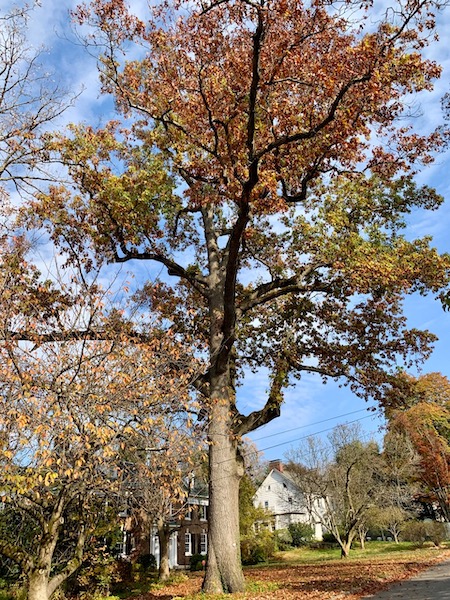 Residents have been advocating to save this 200 year old tree. An applicant wants to build a driveway in front of the house which would compromise the tree's roots.About site plan review for FEMA floodplain and corner lots, accessory building and FAR amendments they are “neutral” or have “no opinion.”
Residents have been advocating to save this 200 year old tree. An applicant wants to build a driveway in front of the house which would compromise the tree's roots.About site plan review for FEMA floodplain and corner lots, accessory building and FAR amendments they are “neutral” or have “no opinion.”
Given the short time frame for enacting the new code, they recommended the assignment of a “drafting committee” to “accurately implement the recommendations, harmonize them with Village code and identify and address unintended consequences.”
Madelaine Eppenstein, President of Friends of the Scarsdale Parks and a a member of the Board of the Scarsdale Forum, sent us this comment about the proposal. "Many if not all land use issues discussed at the Village Board’s work session on May 14, from impervious surfaces to grading with fill, to zoning and bulk have an intimate, existential connection to the ongoing exploitation of Scarsdale’s tree canopy. Responsible development and adequate code provisions should be protecting the Village tree canopy, not helping to destroy it, despite the well-known services trees provide to mitigate flooding, stormwater runoff, sequester carbon dioxide in the air we breathe, and others. Scarsdale Forum’s February report on these issues sets forth specific recommendations for code amendments and a request for a meeting of stakeholders, which, regrettably, has yet to be acknowledged or scheduled by the Village Board."







